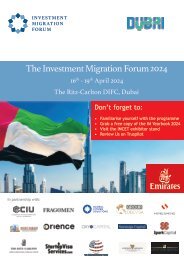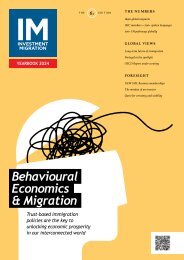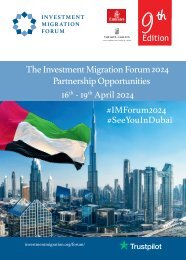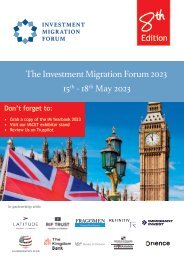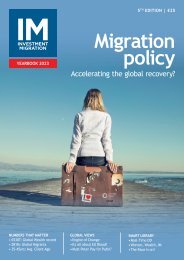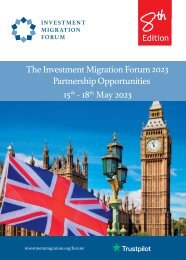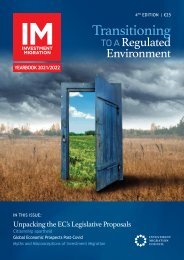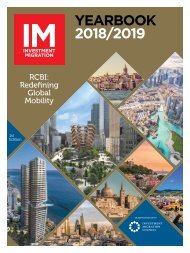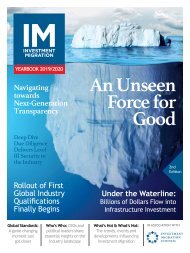IM Yearbook 2020/21
Born from the need for a global, credible, “go-to” publication, the 3rd IM Yearbook offers valuable access to a prime target audience of top industry influencers, decision makers, and the foremost referral network to the world’s most influential Investment Migration programmes: Government officials such as Heads of CIU’s, policy makers, academics, migration agents, law firms, wealth managers, financial advisors, real estate developers, and international firms involved in investment migration.
Born from the need for a global, credible, “go-to” publication, the 3rd IM Yearbook offers valuable access to a prime target audience of top industry influencers, decision makers, and the foremost referral network to the world’s most influential Investment Migration programmes: Government officials such as Heads of CIU’s, policy makers, academics, migration agents, law firms, wealth managers, financial advisors, real estate developers, and international firms involved in investment migration.
Create successful ePaper yourself
Turn your PDF publications into a flip-book with our unique Google optimized e-Paper software.
In conversation with PARAG KHANNA, Global Strategy Advisor, Author and Founder of FutureMap<br />
SOUTHEAST ASIA’S<br />
GROWTH WILL<br />
OUTPACE CHINA’S<br />
China has long been<br />
viewed as Asia’s anchor<br />
economy, but the focus<br />
of global growth is<br />
fast shifting towards<br />
Southeast Asia. The <strong>IM</strong><br />
<strong>Yearbook</strong> spoke with<br />
Parag Khanna about the<br />
Western perception of<br />
Asia, the rise of Southeast<br />
Asia and how it will<br />
affect the investment<br />
migration industry.<br />
Can you tell us a bit about<br />
yourself and your work?<br />
People like to call me a global citizen<br />
because I have lived in many different<br />
countries. I was born in India, grew up in<br />
Abu Dhabi in the UAE, and when I was<br />
seven, we moved to the US. Until I was 16, I<br />
lived in New York. Then I spent one<br />
year in Germany as an exchange<br />
student before returning<br />
to the US to study at the<br />
School of Foreign Service<br />
at Georgetown University.<br />
I became fascinated by<br />
geopolitics from a very early<br />
age. I was 12 when the Berlin<br />
Wall fell. My parents said,<br />
‘we have to go and see<br />
this in person’.<br />
So, we went on<br />
a holiday to<br />
Berlin, and<br />
it was truly<br />
magical to<br />
see history in<br />
the making.<br />
I was hooked<br />
and decided that<br />
I want to work<br />
in this area. Later<br />
in life, I’ve worked<br />
for different think<br />
tanks and government institutions in the<br />
US, Germany, Switzerland and London.<br />
Now I am running my own company,<br />
and I am living in Singapore with my<br />
family. So, migration and a layered<br />
identity are a big part of my own story.<br />
I was born as an Indian citizen, became<br />
American when I was 15, and a few years<br />
ago, I became a Singaporean citizen.<br />
Your last book is called ‘The Future<br />
is Asian’, but you actually argue<br />
that the present is already Asian.<br />
Can you explain this a bit more?<br />
Yes. That’s something people quite<br />
often forget. It is as if we have to wait<br />
for America or Europe to say that<br />
the future or the present is no longer<br />
Western in order for it to be true,<br />
but that’s not the way it works.<br />
When I moved to Asia seven<br />
years ago, the world was<br />
already Asian. If you need<br />
to identify an objective<br />
of convergence, where<br />
it is not a matter of<br />
opinion, you would<br />
say that more than<br />
50% of the world<br />
population is<br />
Asian, and that’s<br />
been true for<br />
quite some time. Then in terms of the<br />
economy, 51% of global GDP in PPP terms<br />
is Asian, and that’s been true for about<br />
two or three years. In addition, the rise of<br />
the Asian Infrastructure Investment Bank<br />
(AIIB) and China’s Belt and Road initiative<br />
marked the launch of new Asia-centric<br />
diplomatic initiatives some five years<br />
ago. I see no objective measure to dispute<br />
the notion that the present is already<br />
Asian. Of course, the present is Asian<br />
doesn’t make for a good book title. So, we<br />
decided to call it ‘The Future is Asian’.<br />
Asia is a very vast and diverse<br />
region. China is leading the charge<br />
today. Which Asian countries<br />
could take on a more important<br />
role in the coming years?<br />
For many policymakers, Asia didn’t matter<br />
until China rose, but Asia as a region has<br />
been rising since the 1950s after it hit rock<br />
bottom. You had the atomic bombs of<br />
Hiroshima and Nagasaki 75 years ago, the<br />
Indian Pakistani partition and genocide<br />
in 1947, as well as the Chinese civil war<br />
that ended in 1949. Asia was on its knees.<br />
Let’s not forget the Vietnam War a couple<br />
of decades later. Japan is the real miracle<br />
story – Japan rose to become the world’s<br />
second largest economy, overtaking West-<br />
Germany in 1975. At that point in time,<br />
100<br />
Investment Migration <strong>Yearbook</strong> 2O2O/2O<strong>21</strong>




